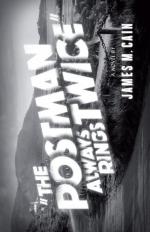|
This section contains 259 words (approx. 1 page at 300 words per page) |
James M. Cain's (1892-1977) controversial bestseller The Postman Always Rings Twice (1934) is an erotic and violent story about a waitress and a drifter who kill the woman's well-heeled, unattractive older husband. Cain's novel is central to the hard-boiled novel/film noir tradition in American popular culture. As in many novels in this genre, an amoral hero falls victim to his own powerful sexual attraction to a beautiful femme fatale. L'amour fou (obsessive love) is at the heart of much of Cain's writing, making it eminently adaptable to film noir—a genre where amorality, violence, and a malevolent fate hang over its often psychologically realistic, morally ambiguous characters.
 Lana Turner and John Garfield in a scene from the film The Postman Always Rings Twice.
Lana Turner and John Garfield in a scene from the film The Postman Always Rings Twice.
Cain's novel has been adapted four times to film: as Ossessione by Luchino Visconti in 1942 (unavailable until very recently because of copyright problems), under its original title in 1946 by Tay Garnett (staring Lana Turner and John Garfield), in 1981 by Bob Rafelson (starring Jessica Lange and Jack Nicholson), and by Marcus DeLeon, in an uncredited version, as Kiss Me a Killer in 1991.
Further Reading:
Cain, James M. The Postman Always Rings Twice. New York, Vintage Books, 1992.
Dyer, Richard. "Four Films of Lana Turner." MOVIE. Vol. 25, Winter 1977-78, 30-52.
Porfirio, Robert G. "Whatever Happened to Film Noir? The Postman Always Rings Twice," Literature/Film Quarterly. Vol. 13, No. 2, 1985, 101-11.
Silver, Alain, and Elizabeth Ward, eds. Film Noir: An Encyclopedic Reference to the American Style. Woodstock, New York, Overlook Press, 1992.
|
This section contains 259 words (approx. 1 page at 300 words per page) |


